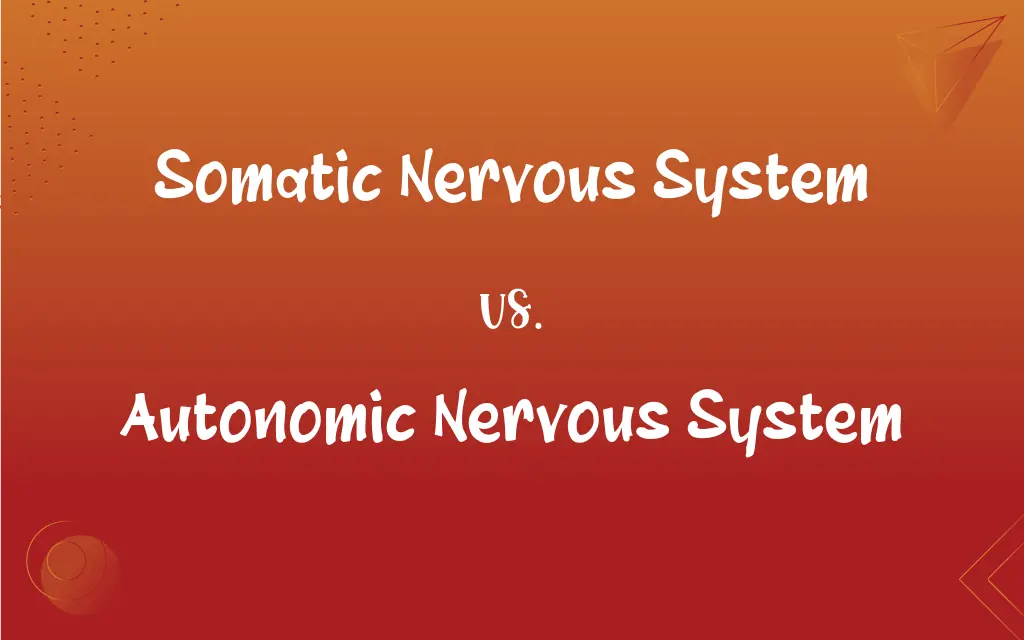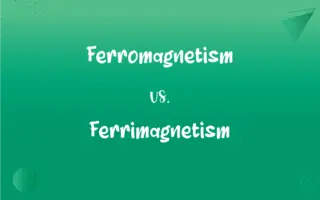Somatic Nervous System vs. Autonomic Nervous System: What's the Difference?
Edited by Aimie Carlson || By Janet White || Published on June 27, 2024
The somatic nervous system controls voluntary movements, while the autonomic nervous system regulates involuntary functions like heartbeat and digestion.

Key Differences
The somatic nervous system and the autonomic nervous system are two major components of the peripheral nervous system, each with distinct functions and roles within the body. The somatic nervous system is responsible for voluntary movements and sensory information processing, allowing conscious control over skeletal muscles. On the other hand, the autonomic nervous system manages involuntary physiological functions, including heart rate, digestion, and respiratory rate, operating without conscious oversight.
The somatic nervous system enables humans to interact with their environment through voluntary actions, such as walking, grasping, or speaking, the autonomic nervous system ensures the internal environment remains stable and efficiently functioning through its sympathetic and parasympathetic divisions. These divisions of the autonomic nervous system work in opposition to maintain homeostasis, with the sympathetic division preparing the body for 'fight or flight' responses, and the parasympathetic division supporting 'rest and digest' activities.
The somatic nervous system's pathways typically involve a single motor neuron connecting the central nervous system to a muscle, facilitating direct and rapid responses. Contrastingly, the autonomic nervous system's pathways often involve two neurons (preganglionic and postganglionic) and a ganglion to transmit signals from the central nervous system to the target organ, allowing for more diffuse and widespread effects.
In terms of interaction with the environment, the somatic nervous system provides the mechanism for outward expression and response to external stimuli, mediated through sensory inputs and motor outputs. Meanwhile, the autonomic nervous system plays a crucial role in internal regulation and adaptation to internal and external stresses, often modulating the body's internal conditions without direct external input.
Understanding the differences between the somatic and autonomic nervous systems is essential for appreciating how the body maintains balance and responds to the environment. While the somatic nervous system empowers individuals with control over their movements, the autonomic nervous system subtly and continuously adjusts internal functions to ensure survival and optimal performance under varying conditions.
ADVERTISEMENT
Comparison Chart
Control Type
Voluntary control over skeletal muscles.
Involuntary control of internal organs.
Functions
Controls conscious movements and reflexes.
Regulates internal organ functions, like heart rate and digestion.
Pathway Complexity
Direct, involving one motor neuron.
Indirect, involving two neurons and a ganglion.
Division
Not divided into further subsystems.
Divided into sympathetic and parasympathetic nervous systems.
Response to Environment
Responds to external stimuli through movement and sensation.
Regulates internal environment, often independent of external stimuli.
ADVERTISEMENT
Somatic Nervous System and Autonomic Nervous System Definitions
Somatic Nervous System
Facilitates reflex actions through spinal cord pathways.
The knee-jerk reaction is a reflex controlled by the somatic nervous system.
Autonomic Nervous System
Manages the 'fight or flight' response through its sympathetic division.
Accelerating heartbeat in a scary situation is governed by the autonomic nervous system.
Somatic Nervous System
Enables conscious perception of touch, pain, and temperature.
Detecting a hot surface with your fingertips is a function of the somatic nervous system.
Autonomic Nervous System
Supports 'rest and digest' activities via the parasympathetic division.
Digesting food efficiently is facilitated by the autonomic nervous system.
Somatic Nervous System
Controls voluntary movements of skeletal muscles.
Deciding to wave your hand involves the somatic nervous system.
Autonomic Nervous System
Regulates involuntary functions of internal organs.
The autonomic nervous system controls your heart rate during exercise.
Somatic Nervous System
Processes sensory information from the external environment.
Feeling the texture of silk is mediated by the somatic nervous system.
Autonomic Nervous System
Balances internal bodily functions to maintain homeostasis.
Regulating blood pressure during changes in posture is managed by the autonomic nervous system.
Somatic Nervous System
Integrates motor commands from the brain to muscles.
Jumping at the start of a race is orchestrated by the somatic nervous system.
Autonomic Nervous System
Modulates body functions without conscious thought.
Adjusting pupil size in different lighting conditions is a task of the autonomic nervous system.
FAQs
What is the main function of the somatic nervous system?
Its main function is to facilitate voluntary movements and process sensory information.
What controls voluntary muscle movements?
The somatic nervous system controls voluntary muscle movements.
How does the autonomic nervous system regulate heart rate?
Through its sympathetic and parasympathetic divisions, adjusting for bodily needs.
What role does the sympathetic nervous system play?
It prepares the body for 'fight or flight' responses to threats.
Can you consciously control your autonomic nervous system?
Generally, no, it operates involuntarily, though some techniques can influence its activity.
How does the autonomic nervous system affect digestion?
It regulates the speed and efficiency of digestion via the parasympathetic division.
Is the somatic nervous system involved in reflex actions?
Yes, it mediates reflex actions through direct pathways in the spinal cord.
What is a unique feature of autonomic nervous system pathways?
They involve two neurons and a ganglion for signal transmission.
Can the somatic nervous system influence internal organs?
No, it primarily controls skeletal muscles and processes external sensory information.
How does the parasympathetic nervous system help after stress?
It promotes 'rest and digest' functions, helping the body recover.
How is sensory information processed differently by these systems?
The somatic nervous system processes external senses, while the autonomic monitors internal organ states.
Why is the somatic nervous system critical for daily activities?
It enables conscious movement and interaction with the environment.
How do the somatic and autonomic nervous systems interact?
While largely independent, they can influence each other indirectly through bodily responses.
What is the significance of the autonomic nervous system's dual divisions?
They provide balance, with one activating and the other inhibiting functions to maintain homeostasis.
How do stress responses differ between the two systems?
The somatic nervous system handles immediate physical responses, while the autonomic manages internal adjustments.
How do autonomic nervous system disorders manifest?
They can lead to problems with heart rate, digestion, and other involuntary functions.
Can diseases affect both the somatic and autonomic nervous systems?
Yes, certain conditions can impact both, though their effects and symptoms might differ.
What research areas involve the somatic and autonomic nervous systems?
Studies range from neurological disorders to the impact of stress and relaxation techniques on bodily functions.
What happens to autonomic functions during exercise?
The sympathetic division increases activity to support enhanced bodily demands.
Can training or meditation affect the autonomic nervous system?
Yes, practices like meditation can influence autonomic responses, like heart rate and stress levels.
About Author
Written by
Janet WhiteJanet White has been an esteemed writer and blogger for Difference Wiki. Holding a Master's degree in Science and Medical Journalism from the prestigious Boston University, she has consistently demonstrated her expertise and passion for her field. When she's not immersed in her work, Janet relishes her time exercising, delving into a good book, and cherishing moments with friends and family.
Edited by
Aimie CarlsonAimie Carlson, holding a master's degree in English literature, is a fervent English language enthusiast. She lends her writing talents to Difference Wiki, a prominent website that specializes in comparisons, offering readers insightful analyses that both captivate and inform.






































































